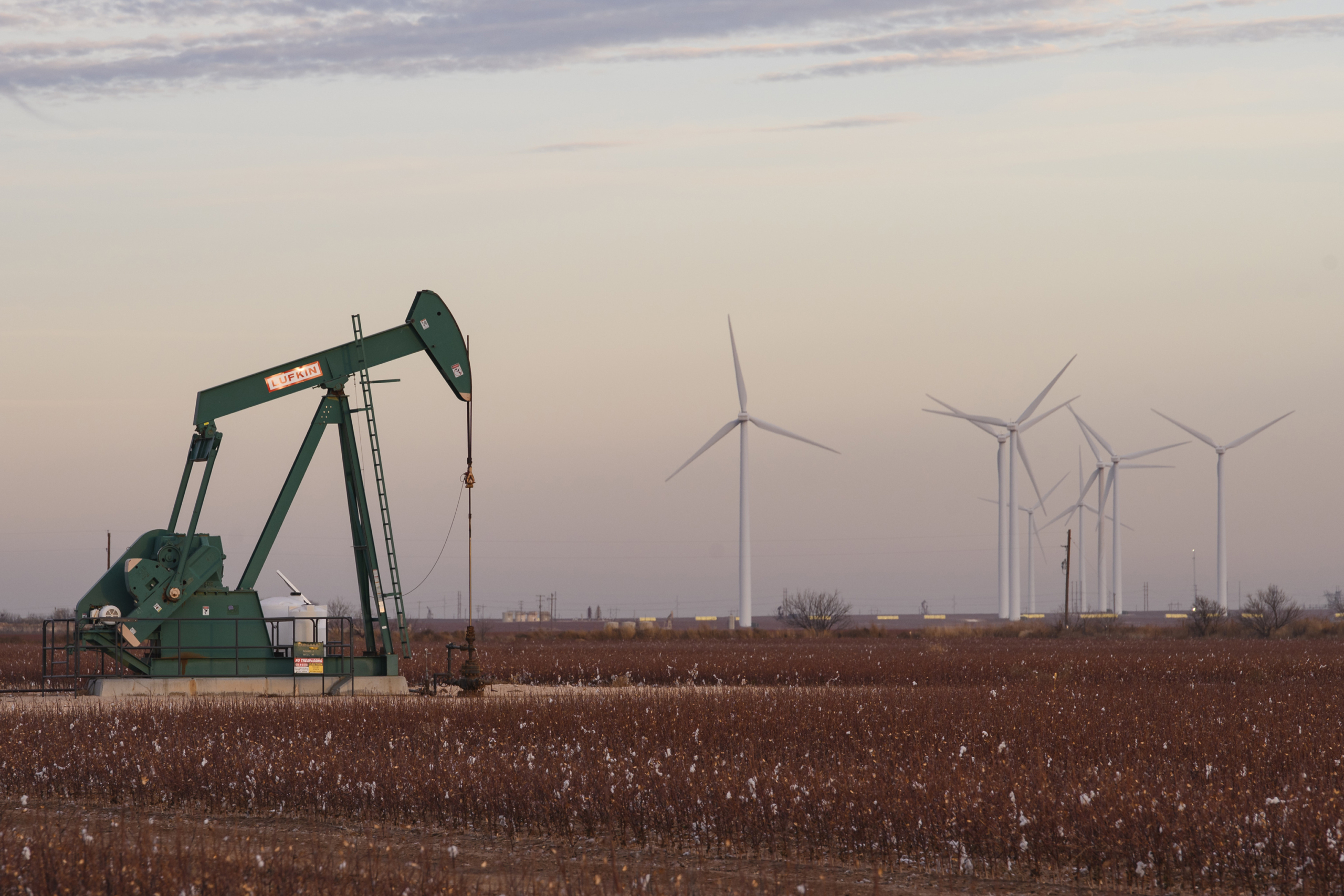Sign up for the daily CJR newsletter.
This column is part of Covering Climate Now, a global journalism collaboration cofounded by CJR and The Nation to strengthen coverage of the climate story. The author is CCNow’s deputy director.
Last week, on the prank and frat-culture podcast Full Send, special guest Donald Trump was asked about the war in Ukraine and how he predicts it will unfold. “Well, and I said this a long time ago,” the former president began, “if this happens, we are playing right into their hands. Green energy. The windmills don’t work. They’re too expensive. They kill all the birds. They ruin your landscapes. And yet the environmentalists love the windmills.”
It was a jarring non sequitur, but it served a purpose. Since even before Russia’s formal invasion of Ukraine commenced, the political right has used the conflict and attendant energy crisis as platforms to excoriate Democratic energy policies and vilify climate action. Pointing to gas prices, which have reached record highs in recent weeks, they’ve blamed Joe Biden for, in their words, banning domestic fossil fuel production and specifically killing the Keystone XL pipeline. Summoning ghosts of slogans past, the solution to rising energy prices, they say, is to “drill, baby, drill.”
These talking points, in addition to being the new subjects of Republican political advertising, have featured prominently in right-wing media—Fox News, the New York Post, the Wall Street Journal opinion section, and all the rest. They’ve received a boost, too, however, from more reputable outlets, many of which have credulously reported Republicans’ charges against the president as little more than routine partisan bickering. That’s unfortunate, because almost all the claims are misleading, at best, or outright false.
First of all, the reason gas prices are high, experts say, is primarily attributable to the coronavirus pandemic. Oil production plummeted amid global lockdowns, and as society has reopened, new production, which involves many labor- and time-intensive processes, has simply not kept pace with rising demand. Further, and contrary to popular understanding, since Russia’s war in Ukraine began, global oil supplies have remained steady—rising gas prices are due to energy traders, whose dealings are largely unregulated, anticipating a future supply reduction, Antonia Juhasz, an investigative journalist and energy expert, explained recently on Democracy Now! As employees of the fossil fuel industry, traders have an incentive to boost profits when possible, and against the backdrop of war that’s exactly what they’ve done. “U.S. oil companies could be asked to limit gasoline price spikes to demonstrate a desire not to profit off of #RussiaWarOnUkraine,” Juhasz wrote on Twitter. “Alternatively, they could be told not to pass the price spike onto consumers by federal and state governments.” These things aren’t happening, though, and thus the current average price for a gallon of gasoline is well over four dollars. As for Keystone XL, even if Biden had not shuttered the project, construction would not have been complete until at least 2023; American imports of Canadian crude oil are up anyway, only transported across the border by different means.
The president, for his part, has done no such thing as ban fossil fuel production at home. Yes, Biden has said the Russia-Ukraine conflict highlights the necessity of a clean energy transition—as have many experts—in that the West would have stronger tools to limit Russia’s aggression were Europe in particular less dependent on Russian fossil fuels. But for all his touting of renewables, Biden in fact granted more oil and gas drilling permits in the first year of his administration than Trump did in any of his four. Jennifer Granholm, Biden’s energy secretary, has repeatedly urged oil executives in the US to drill more (“rig counts up,” she told them in December). The reason domestic production remains low, CNN reported, is due to labor and supply shortages—and the fact that executives, at a time of record profits, have chosen to prioritize shareholder payouts above expensive new production.
So, all of that said, a lot of the fossil fuel boosterism on display from industry representatives and their friends in government “may be more rhetorical ploy than reality,” as Somini Sengupta wrote recently in the New York Times. “There are labor and supply chain constraints, and, anyway, drilling for more oil and gas in the United States now would do nothing to bring down prices in the short term.”
The Times has been among several outlets to cut through the noise in recent weeks, evidenced by this notably direct headline: “Republicans Wrongly Blame Biden for Rising Gas Prices.” Vox’s Rebecca Leber was also on point with an explainer that unpacks and debunks the energy-related myths that dominate right-wing talking points. “There are many problems with these claims, and the stakes of this conversation are very high,” Leber wrote. “The way western Europe and the US respond to this crisis could determine the course on climate change and energy costs in the long run.”
Strong work like this was counterweighted, however, by clumsier coverage elsewhere. Headlines like “GOP blames Biden for gas prices after pushing for Russian oil ban” (ABC News) and “Republicans cheer Russian oil ban and jeer Biden for rising gas prices” (NBC News)—pointed out by Jennifer Rubin in the Washington Post—gave credence to Republican messaging while also reducing a complex and, for many, personal topic to a political spit fight. To boot, on television news programs, Rubin observed, many hosts and anchors were failing to push back on guests making verifiably false claims.
A quick search yielded similar problems in Politico, The Hill, Forbes, and many other outlets. Not all these stories skipped over expertise entirely, but in most the facts of America’s energy situation were buried well beneath the political back-and-forth. In some cases, even outlets aiming to set the record straight struggled. A handful of local news stations, for example, ran with some version of the question “Will opening the Keystone pipeline lower gas prices?” These articles were well-intentioned and answered, unambiguously, “No,” but disinformation experts advise that open-ended framing like this, given that many people will never read past the headline, tends to reinforce the false narrative.
Why does all this matter? Set aside for a moment journalists’ responsibility to be honest moderators of American political discourse. In late February, just after Russia invaded Ukraine, a major new report by the UN warned that climate change is advancing rapidly and might soon outpace humanity’s ability to adapt, unless we halt fossil fuel consumption and rein in other sources of greenhouse gas emissions. The report had its moment in the headlines, but as bombs fell over Kyiv and Russian troops advanced farther into Ukraine, understandably it faded from the news cycle. The fact remains, however, that humanity has vanishingly little time to implement far-reaching change if it hopes to limit global heating to 1.5 degrees Celsius and thereby avoid the worst climate impacts.
For the foreseeable future, every government decision related to fossil fuels and clean energy carries direct implications for our collective climate fortunes. For journalists, then, clarity and accuracy on these subjects aren’t just journalistic best practices—they’re existential imperatives. We should leave cynical politics to the politicians; even in the context of a frightening new war, this is a climate change story. Much coverage of the current energy debate has not mentioned climate at all.
And journalists worried that accuracy here might result in the appearance of partisan bias should rest easy. Planetary survival isn’t a question of Republicans and Democrats—to be certain, it’s not only politicians on the right pushing dubious energy policies. Disinformation in the climate space is challenging enough already; for a long time, journalists fell for it, contributing in no small part to humanity’s current predicament. At this critical juncture, let’s stop doing favors for those willing to argue in bad faith.
Has America ever needed a media defender more than now? Help us by joining CJR today.









